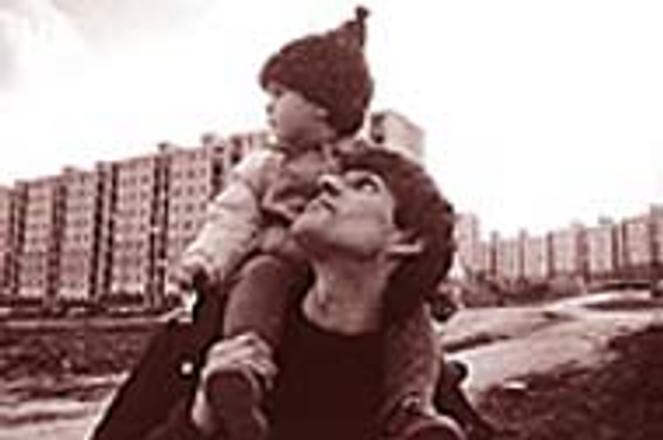Although the Construction Ministry says that Slovakia's paneláky (large concrete blocks of flats) are safe, experts have their doubts.photo: TASR
Residents of western Slovakia had an unusual wake-up call during the early morning hours of July 11. An earthquake registering 4.9 on the Richter scale, whose epicentre was in eastern Austria, rocked many areas of the Bratislava and Trnava regions as well. While no damage was reported, many surprised Slovaks reported having been shaken out of their sleep - and out of their previous belief that a serious quake could never hit their country.
Although Slovakia does not rank among the world's most tectonically active areas, seismologists said they were not surprised by the tremor. Mild quakes are not unusual in this area, they reported, adding that Slovaks should get expect more of the same in the future.
The seismologists' warnings have stirred the fears of many Slovaks who live in paneláky, massive prefabricated concrete housing blocks which have in the past been criticised by both inhabitants and architectural experts for their run-down condition and flawed design.
The housing blocks, which dominate many Slovak towns and are occupied by around 150,000 residents in the Bratislava suburb of Petržalka alone, were built under the former communist regime. Massive panels of concrete were simply stacked atop one another in 'deck-of-cards' style, and were then interconnected and reinforced by metal hooks, some of which have since rusted or disintegrated altogether. Understandably, the July 11 earthquake has awoken concern among paneláky residents as to exactly how much shaking their apartment blocks could withstand.
"I don't feel safe in my flat anyway, never mind the danger of an earthquake," said Gabriela Vitková, a 28 year-old psycholgist who lives on the bottom floor of a Petržalka housing estate.
According to Peter Labák from the Geophysical Institute of the Slovak Academy of Sciences, the situation should not be underestimated. Although Slovakia is an area with relatively mild seismic activity, it is susceptible to large, 'killer' quakes.
"Tectonic activity on Slovak territory has always existed and has not stopped," Labák said. "Slovakia has already experienced strong earthquakes, the largest one in 1763 centred near Komárno which affected an area of about 87,000 square kilometres, killed some 63 people, and destroyed 7 churches and 279 houses."
Seismological research documents evidence of 680 earthquakes since 1034, although experts believe the actual tally to be at least four times as high. But such findings have been lost on city planners, some of whom say that predictions of more earthquakes in Slovakia are nothing short of ridiculous.
"If they [seismologists] didn't say that there would be more earthquakes in the future, they wouldn't have anything to do," said Michal Schmuck, who helped design Petržalka's paneláky in the 1970's.
"This is a very unfortunate comment," Labák responded. "Builders have to consider the possibility of seismic activity when they develop their projects. We know that in the past there were strong earthquakes, and based on our research we know that these earthquakes occur in Slovakia every 150 to 400 years."
Independent architects, meanwhile, cast doubts over the quality of the paneláky and how well they would respond under the pressures of a significant earthquake. "I'm sure that the designers incorporated as many safeguards as the [construction] ministry demanded," said Michael Walshe from the Weldon Walshe EEDC architecture firm. "But the standards of maintenance in such estates is generally very low. This will undoubtedly have had an effect on the ability of the construction materials to maintain their earthquake proofing."
But Schmuck said that paneláky had a life-guarantee varying from 80 to 100 years - although others estimate the lifespan at 30 to 70 years - and that people living in them should worry more about other potential disasters such as gas explosions. "Besides, old brick buildings are more dangerous than paneláky," Schmuck said. "Although [brick buildings] have thicker walls [than the paneláky], they don't have iron linings which make them less vulnerable to earthquakes."
Anton Novotný, head of the construction department at the Construction Ministry, agreed with Schmuck that the paneláky were safer than brick, but admitted that the country's ageing paneláky were already deteriorating without the aid of earthquakes. "We realise that these paneláky are in poor condition. They need to be reconstructed at any price," he said.
The ministry uses maps illustrating the country's most active seismic regions, Novotný continued, and newly constructed buildings must be able to withstand the shaking of an earthquake measuring 6 on the Richter scale. "One of the criteria we use when considering our plan for reconstructing the old paneláky is the seismic activity of a given area," he said.
But Novotný again defended the resilience of the paneláky by comparing it to brick structures. Brick, he said, suffers more severe damage while paneláky are resistant to so-called progressive breakdown, whereby the collapse of one section would lead to the collapse of another. "While an earthquake is very likely to damage brick houses, the same earthquake might only cause one ceiling to crash down at the worst in a panelák," he said. "The probability of progressive breakdown is much lower."
Walshe disagreed: "This type of progressive collapse was first demonstrated tragically at Ronan Point in London," he said. "There, the destruction of a single pre-cast concrete panel resulted in the collapse of 60% of the building. If a tragedy were to happen [in Slovakia], it would not be for want of warning."


